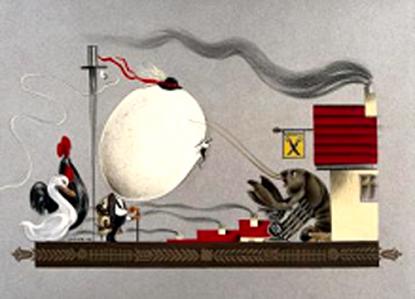2024. April 20. Saturday
The exhibition has closed for visitors.
2003.06.08. - 2003.07.06.
The month-long exhibition at The Ernst Museum, pays back a long outstanding debt and introduces the art of Álmos Jaschik and, through the work of his students, the activities of the design school he founded. Thus it raises a monument to the memory of a remarkable artist and teacher and to his students.

Álmos Jaschik, (1885 - 1950) was a graphic artist, painter, applied artist, distinguished writer and especially gifted teacher of design of the first half of the XXth century, who was later unfairly relegated to the margins by the politics of art. Falling back on national and folk traditions, he developed the ever-widening sphere of his artistic and teaching activities.
Going by his early work, art literature records him mainly as an artist in the Secession style, though his art shows many other directions besides. His work and his illustrations communicate the stories of the great masterpieces of Hungarian poetry and folk culture and are characterized by a deep insight into human nature, a rich imagination and a natural quality.
Jaschik started his career at the Municipal Industrial School of Draughtsmanship at Budapest (1907-1919), and following his work there, opened a graphic design school which went on functioning till his death. His private school, which deserves to be called progressive in spirit, was associated with the literary journals, The Week and The West and its circles.
The school was mostly attended by teenage girls who, when they graduated, got jobs in various branches of the artistic life. Supported by the practical experience of his trade school, Jaschik developed his rationally formulated educational system, tailored to the demands of modern civilization and based on the principle of progressivity.
In the early twenties, through his students, he came into contact with the eurhythmics school of Olga Szentpál Rabinovszky and later, between 1925-1927, lectures on set design and theatre history by Antal Németh, later to be the director of the National Theatre, formed the basis for new activities by the students.
Jaschik was the first in Hungary to teach the building of models for stage sets. For ten years from the mid-twenties, the school presented itself to the public with thematic exhibitions and Jaschik gave an account of the most topical of these in journals on the applied arts. The (fancy dress) balls occasionally held at the school during the thirties, indicate the social contacts the school had and they also served the purpose of displaying the students' talents in designing fancy dress and costumes. Maria Müller, Jaschik's wife, also contributed to the instruction of students in design.
In the early forties Jaschik started a stop-frame animation course for those of his students who were clever with their hands. This is how Jaschik involved his students in his pioneering experiments with animation films of folk tales.
Álmos Jaschik, the spellbinding teacher and the design school he established, deserve a prominent place in the history of Hungarian art education.

Álmos Jaschik, (1885 - 1950) was a graphic artist, painter, applied artist, distinguished writer and especially gifted teacher of design of the first half of the XXth century, who was later unfairly relegated to the margins by the politics of art. Falling back on national and folk traditions, he developed the ever-widening sphere of his artistic and teaching activities.
Going by his early work, art literature records him mainly as an artist in the Secession style, though his art shows many other directions besides. His work and his illustrations communicate the stories of the great masterpieces of Hungarian poetry and folk culture and are characterized by a deep insight into human nature, a rich imagination and a natural quality.
Jaschik started his career at the Municipal Industrial School of Draughtsmanship at Budapest (1907-1919), and following his work there, opened a graphic design school which went on functioning till his death. His private school, which deserves to be called progressive in spirit, was associated with the literary journals, The Week and The West and its circles.
The school was mostly attended by teenage girls who, when they graduated, got jobs in various branches of the artistic life. Supported by the practical experience of his trade school, Jaschik developed his rationally formulated educational system, tailored to the demands of modern civilization and based on the principle of progressivity.
In the early twenties, through his students, he came into contact with the eurhythmics school of Olga Szentpál Rabinovszky and later, between 1925-1927, lectures on set design and theatre history by Antal Németh, later to be the director of the National Theatre, formed the basis for new activities by the students.
Jaschik was the first in Hungary to teach the building of models for stage sets. For ten years from the mid-twenties, the school presented itself to the public with thematic exhibitions and Jaschik gave an account of the most topical of these in journals on the applied arts. The (fancy dress) balls occasionally held at the school during the thirties, indicate the social contacts the school had and they also served the purpose of displaying the students' talents in designing fancy dress and costumes. Maria Müller, Jaschik's wife, also contributed to the instruction of students in design.
In the early forties Jaschik started a stop-frame animation course for those of his students who were clever with their hands. This is how Jaschik involved his students in his pioneering experiments with animation films of folk tales.
Álmos Jaschik, the spellbinding teacher and the design school he established, deserve a prominent place in the history of Hungarian art education.
